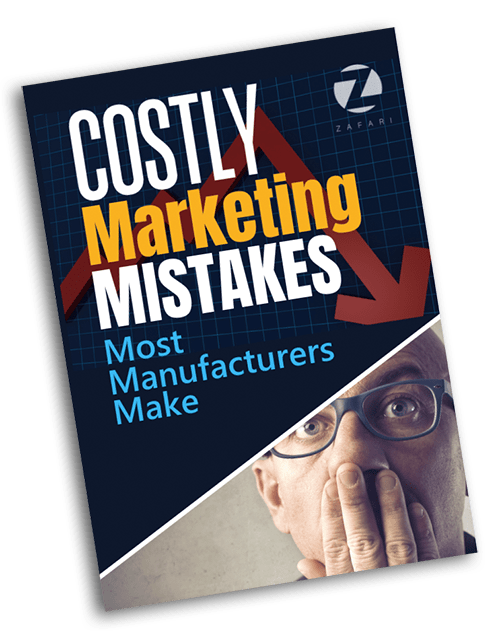Take a stroll through the vintage advertisements of the 20th century, and you’ll get to see captivating phrases like “Drink Coca-Cola,” “Have it Your Way,” or “Go with Kodak.”
These catchy phrases served as early forms of Calls-to-Action (CTAs), meaning that CTAs have been integral to marketing since its inception.
Fast forward to the digital age, and CTAs have become even more crucial, particularly in the realm of digital marketing.
You can see the strategic use of CTAs across the websites of top industrial manufacturers like Caterpillar or Cat, Stanley Black and Decker, and Sandvik. Not having a clear CTA on your website is one of the top mistakes costing your leads.
In this blog, we will walk through the importance of CTAs for your website.
What is a CTA or Call to Action?
A CTA or Call to Action is like request or prompt to encourage visitors to take specific actions like clicking a button, signing up for a newsletter, or making a purchase. CTAs are often used in advertisements, websites, and marketing materials to guide users toward a desired outcome.
A CTA can lead your visitors to fill out a contact form, watch a demo video, grab a special deal, read a company blog, download a PDF, or do something else you want them to do. Common examples include Call Now, Get the Offer, Act Fast, Add to Cart, Buy Now, etc.
Understanding the Importance of Call to Action Buttons
The CTA or call to action is an important element on your website. It acts as a sign board that tells users what to do next, such as if they want to sign up or buy something.
If your webpage is missing a clear CTA, the user may not have any idea about what to do. As a result, they can leave the site without following the path you want them to take.
For example, suppose a visitor lands on your website and views information about the product. However, the page lacks an evident CTA button to make the purchase. It means that the reader is less likely to make a purchase. In fact, they may simply leave the site out of frustration.
If there is a CTA button at the end of the product description, the visitor is more likely to take action.
In a nutshell, a CTA or call to action button lets potential customers know what to do next.
Benefits of Having an Obvious Call to Action Button on Your Webpages
Directing Visitors:
A well-crafted CTA serves as a signpost, guiding visitors toward the next step in their journey. Whether it’s requesting a quote, scheduling a consultation, or downloading a product brochure, CTAs help visitors navigate your website with clear directives.
Generating Leads:
CTAs play a pivotal role in lead generation by encouraging visitors to take action. By prompting users to fill out a contact form or subscribe to a newsletter, you can capture valuable information and expand your pool of leads for future engagement.
Increasing Conversions:
The ultimate goal of any industrial manufacturer’s website is to convert visitors into customers. Strategic placement of CTAs throughout your site can significantly increase conversion rates by prompting visitors to make a purchase, request a demo, or initiate a sales inquiry.
Enhancing User Experience:
CTAs contribute to a seamless and intuitive user experience by providing visitors with clear instructions on how to proceed. By streamlining the navigation process and eliminating confusion, CTAs ensure that visitors have a positive interaction with your website.
Driving Sales and Revenue:
Effective CTAs can directly impact your bottom line by driving sales and generating revenue. Whether it’s prompting visitors to make a purchase online or scheduling a sales call, strategically placed CTAs can accelerate the sales process and boost your company’s profitability.
Tracking Performance:
CTAs offer valuable insights into the effectiveness of your website and marketing campaigns. By tracking click-through rates, conversion rates, and other key metrics associated with CTAs, industrial manufacturers can gain valuable data to inform future optimization efforts.
Building Brand Authority:
Consistently using CTAs across your website reinforces your brand messaging and establishes your company as an authority in your industry. By providing valuable resources, solutions, and opportunities for engagement, CTAs foster trust and credibility among your target audience.
The Placement and Visibility of the CTA Button is Equally Important:
- Make sure your CTA button is easy to find and stands from all the other content.
- Place it near the top of the page or at the end of a section.
- Use contrasting colors and bold fonts to make it more visible.
How Many CTAs Should Be On a Webpage?
The number of Call to Action (CTA) buttons on a webpage depends on various factors, including the page’s purpose and content. Generally, having multiple CTAs throughout the page can provide visitors with more opportunities to engage. However, overcrowding the page with CTAs can be overwhelming and lead to decision paralysis.
It’s essential to strike a balance by placing CTAs strategically where they align with the visitor’s journey and offer clear value. Testing different placements and quantities of CTAs can help determine the optimal approach for your webpage.
Over to You…
Using compelling CTAs on your website is important for driving engagement, generating leads, and ultimately increasing sales and revenue. However, make sure to have them in the right place. In other words, CTAs should be strategically placed across the page. Avoid overcrowding the page with them. This way, you can create a seamless and impactful user experience that drives results for your business.
We at Zafari provide proven, tailored marketing solutions for your industrial manufacturing business.
And it takes you to schedule a FREE STRATEGY CALL to reach out to our experts!






